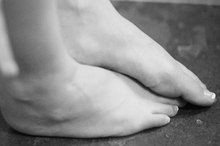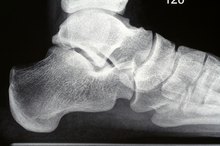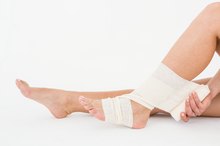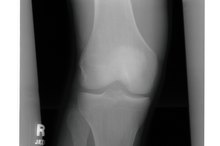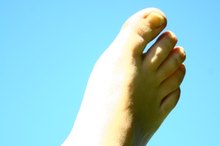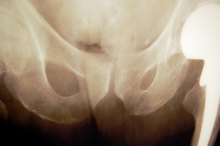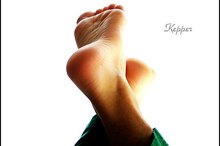What Are the Causes of Lateral Foot Pain?
Numerous conditions can cause lateral foot pain. According to the University of Michigan Medical School, the lateral aspect of the foot--the side of the foot that faces away from the body--is comprised of bones, muscles, tendons and connective tissue. The lateral foot is a common location for foot pain. Lateral foot pain ranges from mild to severe, depending on the cause and the location of the problem. Numerous tissue types can be pain generators in the lateral foot.
If you are experiencing serious medical symptoms, seek emergency treatment immediately.
Cuboid Syndrome
Cuboid syndrome can cause lateral foot pain. According to the Sports Injury Clinic, cuboid syndrome occurs when the peroneus longus--a long, thin muscle in the lateral compartment of the leg--applies too much traction on the cuboid bone, causing it to partially dislocate 1. The block-like cuboid bone is one of seven tarsal bones in the foot. It's located on the lateral side of the foot, and it forms joints with several other foot bones. Common signs and symptoms associated with cuboid syndrome include pain in the lateral part of the foot during weight bearing activities, a coexisting ankle inversion sprain and significant overpronation or a rolling inward of the feet and ankles. The Sports Injury Clinic website states that effective treatment methods for cuboid syndrome include manipulation of the cuboid back into position and treating peroneal tendinitis, which may occur in conjunction with a partially dislocation cuboid 1.
Inversion Sprain
Causes of Chronic Ankle & Foot Pain
Learn More
An ankle inversion sprain can cause lateral foot pain. The American Academy of Podiatric Sports Medicine states that an inversion sprain is characterized by damage to the anterior talofibular and calcaneofibular ligaments--important ligaments on the outside aspect of the ankle 2. The degree of damage varies from person to person based on the forces involved in the injury. In some cases, the injured ligaments and connective tissue may suffer a mild stretch, while in other cases, the ligaments may partially or completely tear. According to the AAPSM, common signs and symptoms associated with an inversion sprain include pain in the lateral ankle and foot, an audible pop or snap heard at the time of injury and an inability to bear weight on the injured ankle. Initial treatment of the injury with rest, ice, compression and elevation to reduce pain and swelling is appropriate within the first 24 to 48 hours following injury.
- An ankle inversion sprain can cause lateral foot pain.
- According to the AAPSM, common signs and symptoms associated with an inversion sprain include pain in the lateral ankle and foot, an audible pop or snap heard at the time of injury and an inability to bear weight on the injured ankle.
Tarsal Coalition
Tarsal coalition can cause lateral foot pain 3. According to Foot Health Facts, tarsal coalition is an atypical bony, cartilaginous or fibrous connection or bridge between two tarsal bones 3. In most cases, tarsal coalition occurs during fetal development, causing the tarsal bones to form improperly 3. Other possible causes of tarsal coalition include infection, inflammatory joint diseases such as arthritis and previous trauma in the affected area 3. Reduced active range of motion in the involved segments is another sign or symptom associated with this condition.
Related Articles
References
- Sports Injury Clinic: Cuboid Syndrome
- American Academy of Podiatric Sports Medicine: Ankle Sprain
- Foot Health Facts: Tarsal Coalition
- Dawe EJ, Davis J. (vi) Anatomy and biomechanics of the foot and ankle. Orthopaedics and Trauma. 2011;25(4):279-286. doi:10.1016/j.mporth.2011.02.004
- Ombregt L. Applied anatomy of the lower leg, ankle and foot. A System of Orthopaedic Medicine. March 2013. doi:10.1016/b978-0-7020-3145-8.00090-9
- Brockett CL, Chapman GJ. Biomechanics of the ankle. Orthop Trauma. 2016;30(3):232–238. doi:10.1016/j.mporth.2016.04.015
- Golightly YM, Hannan MT, Dufour AB, Hillstrom HJ, Jordan JM. Foot Disorders Associated With Overpronated and Oversupinated Foot Function. Foot & Ankle International. 2014;35(11):1159-1165. doi:10.1177/1071100714543907
- Pinney SJ, Sangeorzan BJ. Fractures Of The Tarsal Bones. Orthopedic Clinics of North America. 2001;32(1):21-33. doi:10.1016/s0030-5898(05)70191-7
- Shakked RJ, Walters EE, O'Malley MJ. Tarsal navicular stress fractures. Curr Rev Musculoskelet Med. 2017;10(1):122–130. doi:10.1007/s12178-017-9392-9
- Hawke F, Burns J. Understanding the nature and mechanism of foot pain. J Foot Ankle Res. 2009;2:1. Published 2009 Jan 14. doi:10.1186/1757-1146-2-1
- Shaked, R., Walters, E., and M. O’Malley. Tarsal Navicular Stress Fractures. Current Reviews in Musculoskeletal Medicine. 2017 Jan 21. (Epub ahead of print).
Writer Bio
Martin Hughes is a chiropractic physician, health writer and the co-owner of a website devoted to natural footgear. He writes about health, fitness, diet and lifestyle. Hughes earned his Bachelor of Science in kinesiology at the University of Waterloo and his doctoral degree from Western States Chiropractic College in Portland, Ore.
